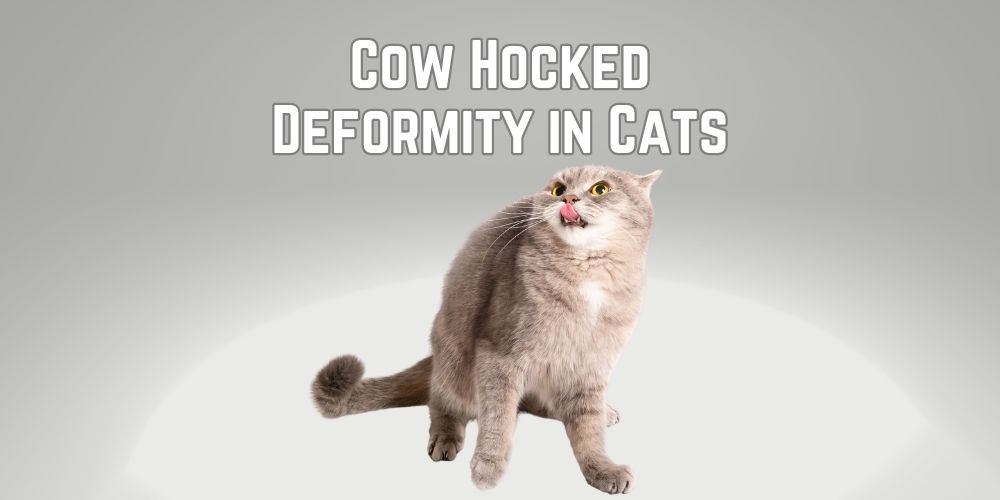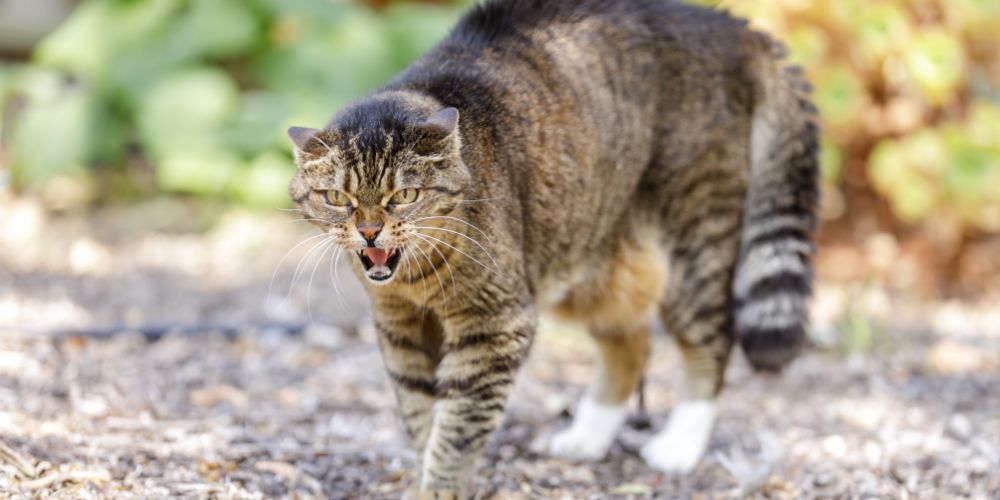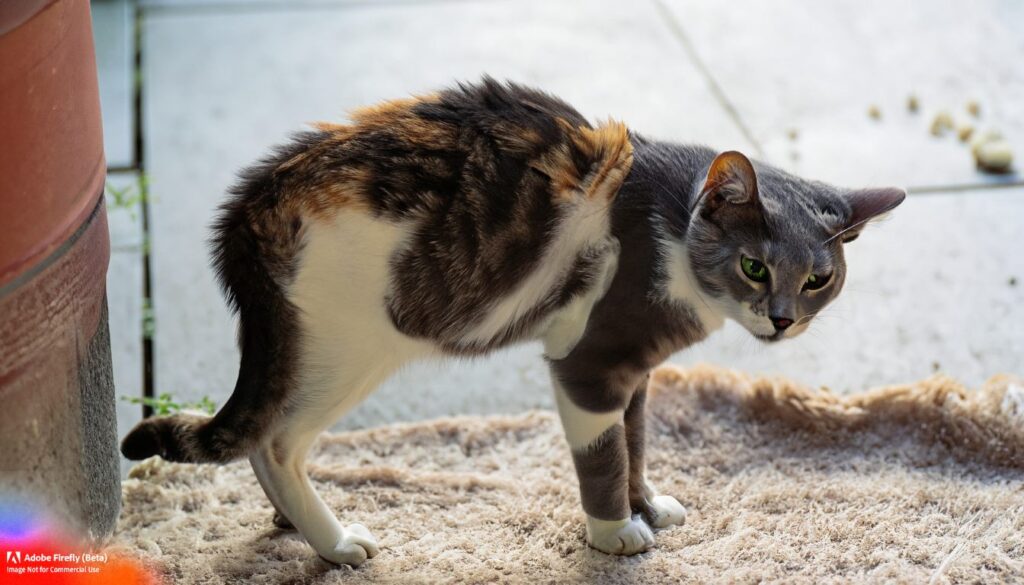
Cow hocked deformity, also known as cow hocks or bowleggedness, is a term used to describe a specific physical condition in cats where the hind legs turn inward, causing the hocks (the joints in the hind legs) to appear closer together. This condition can affect a cat’s gait and overall posture. In this article, we will delve into the details of cow hocked deformity in cats, including its causes, potential consequences, and available treatment options.
Table of Contents
Introduction
Cats are known for their agility and grace, but some individuals may develop a condition called cow hocked deformity, which affects the alignment of their hind legs. This condition can have varying degrees of severity and may impact a cat’s mobility and overall well-being.
Understanding Cow Hocked Deformity in Cats
Cow hocked deformity refers to a structural abnormality in a cat’s hind legs, where the hocks turn inward instead of being aligned straight. This causes the hind legs to appear bowlegged or “cow hocked.” The deviation from the normal alignment can affect the cat’s balance, coordination, and movement.
Why is my cat bow-legged?
Bow-leggedness in cats can have various causes, including genetic factors, nutritional imbalances, growth abnormalities, or developmental issues. Bow-leggedness refers to a condition where the legs of the cat curve outward instead of being straight. It can affect one or both legs and may cause difficulty in walking or running.
Causes of Cow Hocked Deformity
Cow hocked deformity in cats can have several causes, including genetic factors, developmental issues during growth, nutritional imbalances, and certain medical conditions. In some cases, the condition may be present at birth, while in others, it may develop as the cat grows. Breeding programs that do not prioritize structural soundness can also contribute to the prevalence of cow hocked deformity.
7 Cat Cow-Hock Symptoms
Here are the symptoms of cat cow-hock, listed pointwise:
- Abnormal limb positioning: One of the primary symptoms of cat cow-hock is the inward angulation of the hind limbs. When viewed from behind, the hocks (the joint in the hind leg) appear closer together than normal.
- Narrow gait: Cats with cow-hock often have a narrower and more restricted gait. Their hind legs may seem to brush against each other while walking or running, causing them to move with less ease and agility.
- Paddling or swaying movement: Another symptom is a paddling or swaying motion of the hind legs while walking or running. This can be observed as the cat’s paws turning inward or outward as they move, rather than pointing straight ahead.
- Lack of balance and stability: Cats with cat cow-hock may struggle with maintaining balance and stability. They may be more prone to stumbling, tripping, or falling, particularly when attempting sharp turns or sudden changes in direction.
- Difficulty jumping or climbing: Due to the altered positioning and angulation of their hind legs, cats with cat cow-hock may have difficulty jumping or climbing. They may lack the power and coordination required for these activities, resulting in reduced mobility.
- Muscle stiffness or weakness: Some cats with cat cow-hock may exhibit signs of muscle stiffness or weakness in their hind legs. This can manifest as difficulty in extending or flexing the limbs fully, reduced muscle tone, or decreased muscle mass.
- Orthopedic issues: Over time, the abnormal alignment of the hind limbs can put extra stress on the joints, ligaments, and bones, potentially leading to orthopedic issues such as arthritis, joint pain, or even injuries like sprains or strains.
It’s important to note that if you suspect your cat may have cat cow-hock or any other health issue, it’s best to consult a veterinarian for a proper diagnosis and appropriate treatment.

Identification and Diagnosis
Identifying cow hocked deformity in cats is usually straightforward, as the inward deviation of the hind legs is visible. However, a veterinary examination is necessary to determine the severity of the deformity and identify any underlying causes. X-rays and other diagnostic tests may be conducted to evaluate the joints, bones, and overall structure of the hind legs.
Can cow hocks be corrected?
Cow hocks in cats can sometimes be corrected, depending on the underlying cause and severity of the condition. In mild cases, management strategies, such as physical therapy and environmental modifications, may help improve the cat’s gait and muscle strength.
However, in more severe cases or when the abnormality significantly affects the cat’s quality of life, surgical interventions, such as corrective osteotomy or joint stabilization, may be considered. It’s crucial to consult with a veterinarian who can assess the specific condition of your cat and provide appropriate recommendations for correction.
difference between sickle hocked and cow-hocked
Sickle hocked and cow-hocked are two distinct terms used to describe different leg abnormalities in animals:
- Sickle hocks: This term refers to a condition where the hocks (the joint in the hind leg) are excessively angulated, causing the legs to appear curved or bent forward. It resembles the shape of a sickle or a crescent moon. Sickle hocks can affect the cat’s gait and overall movement.
- Cow-hocked: Cow-hocked, on the other hand, refers to a condition where the hocks of the hind legs turn inward, causing the legs to appear closer together at the hock joint. This gives the appearance of the hind legs coming together like a cow’s hind legs. Cow-hocked cats often have a narrower gait and may experience difficulties with balance and stability.
Both sickle hocks and cow-hocks are considered structural abnormalities and may affect the cat’s mobility. It’s important to consult with a veterinarian for an accurate diagnosis and appropriate management or treatment options.

Potential Consequences and Complications
Cow hocked deformity can have various consequences for cats. The abnormal leg alignment can put strain on the joints, ligaments, and muscles, potentially leading to discomfort, pain, and an increased risk of injuries. Cats with severe cow hocked deformity may experience difficulties with mobility and balance.
Treatment Options for Cow Hocked Deformity
The treatment options for cow hocked deformity in cats depend on the severity of the condition and the underlying causes. In some cases, surgical intervention may be recommended to correct the leg alignment. However, not all cases require surgery, and less severe deformities can often be managed with non-surgical approaches, such as physical therapy, exercises, and supportive measures.
Cat cow-hock is a structural abnormality in the alignment of the hind limbs, and it typically requires professional veterinary attention. stomach rub, kneading, butt rub dance, cushion stretching, wheelbarrow, scrunchie on the paw, rock on, begging do not address the underlying condition of cat cow-hock. but they can be used to comfort and easy the condition to some extent.
Treatment options for cat cow-hock may include:
- Veterinary Examination: A thorough examination by a veterinarian is essential to determine the severity of the condition and rule out any other underlying health issues.
- Management Strategies: Depending on the individual cat’s condition, management strategies may be recommended. This can include weight management, exercise modification, and environmental adaptations to minimize stress on the joints.
- Physical Therapy: In some cases, physical therapy exercises can help improve muscle strength, range of motion, and coordination in the affected limbs. These exercises should be prescribed and guided by a veterinarian or a veterinary rehabilitation specialist.
- Orthopedic Interventions: In severe cases or when the abnormality significantly affects the cat’s quality of life, surgical interventions may be considered. Orthopedic procedures, such as corrective osteotomy or joint stabilization, aim to improve the alignment and function of the hind limbs.

Managing Cow Hocked Cats’ Comfort and Mobility
Cats with cow hocked deformity can benefit from certain measures to enhance their comfort and mobility. Providing them with a safe and accessible environment, including soft and supportive bedding, can help alleviate discomfort and reduce the strain on their joints. Regular exercise and maintaining a healthy weight are also important for managing their overall well-being.
Physical Therapy and Rehabilitation
Physical therapy and rehabilitation techniques can play a significant role in managing cow hocked deformity in cats. These may include exercises to improve muscle strength, balance, and coordination, as well as range-of-motion exercises to maintain joint flexibility. A veterinarian or a certified animal rehabilitation specialist can provide guidance and develop a tailored therapy plan.
Supportive Measures for Cats with Cow Hocked Deformity
Supportive measures can help alleviate the challenges faced by cats with cow hocked deformity. Using assistive devices like ramps or steps can make it easier for them to access elevated surfaces. Additionally, providing joint supplements, such as glucosamine and chondroitin, can support joint health and reduce inflammation.
Preventive Measures for Kittens and Breeding Programs
Preventing cow hocked deformity starts with responsible breeding practices. Breeding programs should prioritize the selection of cats with healthy structural conformation. Additionally, providing proper nutrition during a kitten’s growth phase and ensuring adequate exercise and socialization can contribute to their overall development and reduce the risk of deformities.
Importance of Veterinary Consultation
If you suspect or notice signs of cow hocked deformity in your cat, it is crucial to consult with a veterinarian. A veterinarian can provide an accurate diagnosis, evaluate the severity of the condition, and recommend appropriate treatment options. Regular check-ups and monitoring are essential to ensure the cat’s well-being and manage any potential complications.
Living with a Cow Hocked Cat
Living with a cow hocked cat requires understanding and providing appropriate care. By creating an environment that supports their mobility, ensuring a balanced diet, and addressing their specific needs, you can help them lead a fulfilling and comfortable life.
Conclusion
Cow hocked deformity in cats can impact a cat’s mobility and overall well-being. With proper veterinary care, treatment, and supportive measures, the challenges associated with this condition can be managed effectively. By prioritizing the cat’s comfort, providing necessary interventions, and seeking professional advice, you can help your cow hocked cat live a happy and fulfilling life.
FAQs
FAQ 1: Is cow hocked deformity painful for cats?
Cow hocked deformity can potentially cause discomfort and pain for cats, especially if the condition is severe or leads to complications. Regular veterinary assessment and appropriate treatment can help manage pain and enhance the cat’s comfort.
FAQ 2: Can cow hocked deformity be corrected?
In some cases, surgical intervention can correct the alignment of the hind legs in cats with cow hocked deformity. However, not all cases require surgery, and less severe deformities can often be managed through non-surgical approaches, such as physical therapy and supportive measures.
FAQ 3: Are certain cat breeds more prone to cow hocked deformity?
While cow hocked deformity can occur in cats of any breed, some breeds may have a higher prevalence due to genetic factors or breeding practices. However, it is important to note that responsible breeding programs prioritize the health and structural soundness of the cats, which can help minimize the occurrence of deformities.
FAQ 4: Can cow hocked deformity affect a cat’s quality of life?
Cow hocked deformity can impact a cat’s quality of life, particularly if it leads to pain, discomfort, or mobility challenges. However, with appropriate care, treatment, and support, many cats with this condition can lead fulfilling lives and adapt to their unique circumstances.
FAQ 5: How can I support a cat with cow hocked deformity?
Supporting a cat with cow hocked deformity involves creating an environment that accommodates their needs, providing appropriate veterinary care, and implementing supportive measures such as physical therapy, joint supplements, and modifications to their surroundings. Regular veterinary consultations and monitoring are crucial to ensure their well-being and address any complications that may arise.

Hi, This is Alexa, and I love cats. This Website is a Complete Journal about how to travel with a cat and other information about Cat Health, Cat Training, Cat Behavior, Cat Foods and more. I hope you find it useful.
